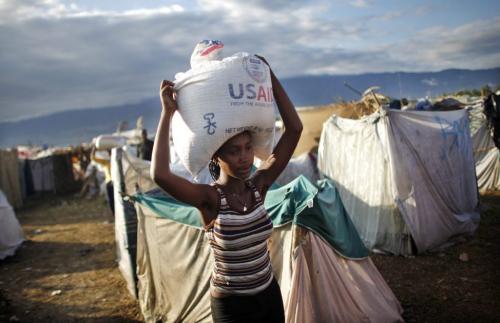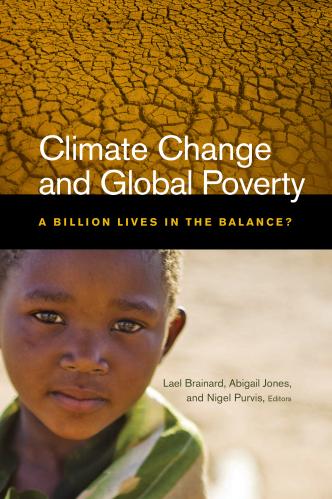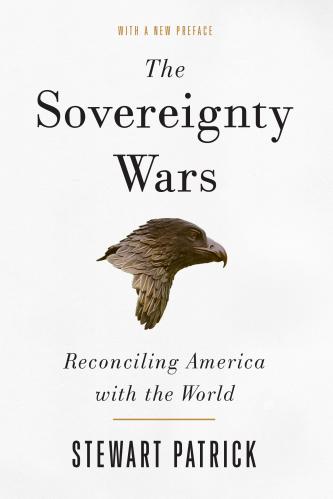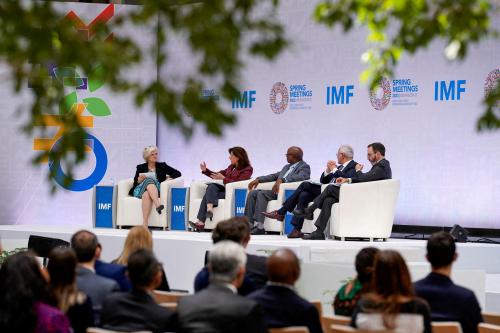Vladimir Lenin wrote a pamphlet in 1916 called Imperialism: The Highest Stage of Capitalism: “Imperialism is capitalism at that stage of development at which…the division of all territories of the globe among the biggest capitalist powers has been completed.”
Imagine Lenin’s puzzlement if he were alive to see the territories of the globe divided up not among capitalists but among foreign aid bureaucrats. I am exaggerating a little; but a surprising new trend among development economists, foreign aid organizations, and Western policymakers is the willingness to combine foreign military intervention with traditional aid work. This takes even further a tendency that began in the 1980s toward increasing intrusiveness of foreign aid programs in poor societies’ economic policies and political institutions. In short, foreign aid has been getting ever more imperial over the past quarter-century. While foreign aid may be squeezed by the current financial crisis, the aid-military complex seems likely to thrive in view of the many threats to security in different parts of the world. Indeed, on October 13, 2008, right after the worst week in US stock market history, World Bank President Robert Zoellick found time in a major speech to talk about how the World Bank was “bringing security and development together.”
The US government has just established a regional military command in Africa, AFRICOM, which it justifies not as a military initiative but as part of a growing effort to promote African development. The head of the AFRICOM Transition Team, Rear Admiral Robert Moeller, said that “strategic success” for AFRICOM would be defined as “an African continent that knows liberty, peace, stability, and increasing prosperity,” not to mention “democratic governance.” The share of US foreign aid distributed by the Pentagon increased from 6 percent in 2002 to 22 percent in 2005.[1]
According to a new US Army manual released to the press on February 8, 2008, “shaping the civil situation” is as important to the Army’s mission in foreign lands as “winning battles.”[2] Under the rubric of “counterterrorism,” the Department of Defense is constructing schools in coastal Kenya, and digging wells and manning health clinics throughout the Horn of Africa—at the same time as the American military has been backing Ethiopia’s invasion of its bitter enemy Somalia.
Following the Bush administration’s failures in using civilian experts in the occupation and reconstruction of Iraq, the US State Department, the traditional home of foreign aid policy, has been advocating bringing even more civilian experts into future military operations abroad. In a speech at Georgetown on February 12, Secretary of State Condoleezza Rice described the creation of a Civilian Reserve Corps, including economists, public administrators, public health officials, agronomists, and city planners who could
deploy with the 82nd Airborne within 48 hours of a country falling into conflict. These first responders would be able to summon the skills of hundreds of civilian experts across our federal government, as well as thousands of private volunteers.[3]
In 2005, a new State Department office called the Coordinator for Reconstruction and Stabilization published a list of its aims on its Web site. Soldiers and social scientists would work together to move a society from war to “legitimate and stable security institutions.” They would work to “legitimate political institutions and participatory processes” and go on to a “long-term development program.” They would achieve a “functioning legal system accepted as legitimate and based on international norms.”
The Web site also listed 1,179 concrete steps the agency would take to carry out these goals. These include, for example, the need to “maintain positive relations with indigenous population,” to “identify and dismantle organized crime networks,” to “assess needs for prosthetic limbs in population,” and to “improve drainage during road construction to reduce excessive runoff.”[4] (The gap between these ludicrously ambitious goals and the pathetic aid outcomes in Iraq—is the power fully restored?—and Afghanistan raises the question of whether this development rhetoric is in part meant to improve PR for the military actions, an issue to which I will return.)
The British government has been thinking along similar lines. In a 2006 report, the British aid agency, the Department for International Development (DFID), announced:
The growing awareness of the linkages between conflict prevention and poverty reduction…and the importance attached to helping rebuild countries emerging from conflict all serve to emphasize the need for DFID to work effectively with the military.[5]
Then there is the United Nations, which currently has more than 100,000 peacekeeping soldiers deployed in nineteen conflicts. According to a UN report last year, the Blue Helmets are meant not only to foster peace but “are also mandated to support the restoration and enhancement of essential services…and help to tackle the root causes of conflict.”[6] The entire UN system, including aid workers and peacekeepers, should work together on preventing deadly conflict and combating poverty.[7]
International aid organizations have also begun linking military intervention to fighting poverty. The World Bank was among the first when it suggested in a prominent 2003 report, Breaking the Conflict Trap, that aid combined with military action “could avert untold suffering, spur poverty reduction, and help to protect people around the world from…drug-trafficking, disease, and terrorism.” The report suggested that such combined action could halve the probability of a civil war breaking out in a poor country from precisely 44 percent to 22 percent.[8]
This new approach to foreign aid has been encouraged, in part, by the concern of Western governments since September 11 that terrorist groups are emanating from war-torn, impoverished societies. But the influence of social scientists, building upon decades of thinking about poverty and development, should not be underestimated. The principal author of the 2003 World Bank report was Paul Collier, at that time head of the bank’s Development Research Group, a noted Africanist, and one of the world’s leading experts on civil war and the reconstruction of failed states. He has since returned to his longstanding professorship in economics at Oxford University, where he has written his new book, The Bottom Billion, which brings together for general audiences his academic research on the world’s poorest countries. (He defines the “Bottom Billion” as the people living in “the minority of developing countries”—over fifty nations, mostly in sub-Saharan Africa and Central Asia—that are not developing but moving backward, and that occupy the lowest position in the global economy.)
The Bottom Billion is an eloquent and compassionate description of the plight of people in these countries and a plea for robust international intervention. Professor Collier’s thesis is that the poorest countries are trapped in a vicious circle of poverty, civil war, military coups, looting of natural resources, and failed states. They need outside rescue by the rich nations. “The evidence is against…internal solutions,” he writes, and “breaking the conflict trap and the coup trap are not tasks that these societies can readily accomplish by themselves.” He closes each section with a list of recommendations for rescue actions by the Group of 8 rich nations.
Collier’s recommendations are very specific and based on detailed cost/benefit calculations. For example, he writes:
Aid is not very effective in inducing a turnaround in a failing state; you have to wait for a political opportunity. When it arises, pour in the technical assistance as quickly as possible to help implement reform. Then, after a few years, start pouring in the money for the government to spend.
Regarding the use of force, he writes:
Security in postconflict societies will normally require an external military presence for a long time. Both sending and recipient governments should expect this presence to last for around a decade, and must commit to it. Much less than a decade and domestic politicians are liable to play a waiting game rather than building the peace…. Much more than a decade and citizens are likely to get restive for foreign troops to leave the country.
For Collier, “a credible military guarantee of external intervention” can achieve not only peace but also political stability. He is not discouraged by some of the recent difficulties faced by foreign armies, such as in Iraq. He points out that “the British intervention in Sierra Leone…has been a huge success.” The lesson, for Collier, is that “we should intervene, but not necessarily everywhere. Sierra Leone rather than Iraq is the likely future of intervention opportunities in the bottom-billion countries.” The foreign army should replace the local one:
International security forces should likewise be committed for the long haul. In return, postconflict societies should reduce their own military spending…it is dysfunctional.
The Bottom Billion, of course, is not only about foreign military intervention. It also discusses the trade policies of rich countries toward the poorest countries, international standards to block trade in “conflict diamonds”— diamonds that derive from mines controlled by rebel groups or factions, and that are used to fund military conflicts —and traditional foreign aid. Collier is not as optimistic about aid as Columbia Professor Jeffrey Sachs, who wrote a book about what he foresaw as the achievement of aid: The End of Poverty. Collier describes his own position as advocating a reasonable middle way between aid optimists and pessimists. However, Sachs in turn is often hostile toward foreign military intervention, so perhaps Collier is not so much in the middle as optimistic in a different direction. Military intervention is the most controversial tool that Collier wants to deploy according to his precise criteria for helping the poorest countries.
Where does this precision come from? To a social scientist, the world is a big laboratory. We have data on which societies have wars, how poor they are, which ones have military coups, which ones have military interventions, which ones get aid and of what kind, which ones export diamonds. We can calculate statistical associations among all of these factors. We can also do many case studies of war, peace, and nation-building. Collier is unusually confident for a social scientist that this data can be used as a guide to action:
We have, in fact, the building blocks for a system. The risk of conflict differs according to economic characteristics, and the economic characteristics are affected by conflict. It is possible to set up this interaction as a model that predicts in a stylized fashion how the incidence of conflict is likely to evolve. I joined forces with Harvard Hegre, a young Norwegian political scientist, and we built one.
Alas, as a social scientist using methods similar to Collier’s in my research, I am painfully aware of the limitations of our science. When recommending an action on the basis of a statistical correlation, first of all, one must heed the well-known principle that correlation does not equal causation. There is a high correlation between wearing an expensive suit with cufflinks and being well-to-do, but putting on cufflinks does not make you rich. To establish a basic rationale for action, Collier would have to show that his correlations between actions and outcomes are causal, that actions cause outcomes.
The MIT economist Daron Acemoglu, recently the winner of the prestigious John Bates Clark Medal for best economist under forty, made exactly this criticism of the World Bank’s research on civil war:
Contrary to the claims in the paper, the regression evidence does not test any well-specified hypothesis, and the correlations that are interpreted as causal effects are really no more than correlations…. It is too early to jump to policy conclusions.[9]
I am forced to make a similar criticism of Collier’s book—he fails to establish that the measures he recommends will lead to the desired outcomes. In fairness to Collier, it is very difficult to demonstrate causal effects with the kind of data we have available to us on civil wars and failing states. As Collier writes, “our model cannot be used for prediction.” In the research papers on which his book is based, Collier does give abundant caveats that show he understands the limits of correlations for inferring that actions cause outcomes. But the caveats are not as apparent in the book, and Collier does not explain to the reader just why he recommends precise actions so confidently on the basis of mere correlations.
Of course, governments take many actions even when social scientists are unable to establish that such actions will cause certain desirable outcomes. Presumably they use some kind of political judgment that is not based on statistical analysis. What is unusual about Collier’s book is that he seems to offer statistical analysis as a replacement for political judgment, or perhaps unintentionally gives scholarly cover for actions that governments want to take anyway. The press shows a certain reverence for social science work with statistics that can make this cover quite effective. The paradox is that many social scientists familiar with this kind of analysis do not share the press’s reverence.
This is not the end of the pitfalls of social science research that Collier encounters. An important part of his argument is that the Bottom Billion will not get out of poverty by themselves, because they are “trapped” by their pervasive wars, military coups, and looting of natural resource wealth. There certainly is an element of truth in this argument—all of these factors are undeniably inhibiting Africa’s growth. But are those at the “bottom” literally trapped, waiting for outside rescue by the G-8?
Collier comes perilously close to another statistical fallacy known as selection bias. He chose the countries that belong to his Bottom Billion on the basis of their poverty today, and then points out that they also have had very poor growth during the preceding four decades—as has been the case, for example, with Angola, Haiti, Liberia, Sierra Leone, Somalia, and Zaire/ Congo. The implication is that the poorest nations will in the future continue to have very low economic growth.
But there is actually no evidence that the Bottom Billion at the beginning of a forty-year period will have worse economic growth over the subsequent forty years than rich nations. What Collier did was select which countries are poor at the end of the period, so of course they will also be the ones that previously have had a long string of very low growth rates—if they had previously had high economic growth, then they wouldn’t be poor at the end.
Of course, Collier is quite right to show compassion for those countries that have had such negative growth as to wind up at the bottom today. Perhaps he worries that this negative record is likely to continue indefinitely. Yet the historical evidence suggests that this is an ungrounded assumption—growth reversals among poor nations are common in both directions. Côte d’Ivoire, Kenya, Nigeria, Togo, and Zimbabwe had good growth between 1960 and 1980, before falling prey to economic decline—brought on by political disasters and other factors—from 1980 to the present. Conversely, Bangladesh, India, Uganda, and Vietnam had mediocre to negative growth between 1960 and 1980, before registering impressive growth from 1980 to the present. If there is so much movement into and out of success and failure, it is hard to argue looking forward that the Bottom Billion are trapped in failure.
These may sound like arcane statistical debates when you are trying to decide whether to save a poor country. But if you are going to recommend military intervention based on social science research—in short, if you are going to read Collier’s book and draw conclusions from it—then you have to face up to the technical fallacies that may lurk behind research findings. Alas, we have now seen two common fallacies appearing in the book, “correlation equals causation” (which spuriously concluded that UN peacekeeping forces cause peace) and “selection bias” (which made it appear that the Bottom Billion were trapped in low income and low growth, when no such conclusion is established by historical evidence).
These technical fallacies in Collier’s analysis also raise questions concerning his conclusions about when and how to use military force or any other kind of foreign intervention. He illustrates his statistical results with anecdotal examples of military intervention, as we have already seen, as possible precedents for future military action. He strongly supports the widespread view that Western intervention could have prevented the 1994 Rwanda genocide. Rwanda is certainly a tragic case that discredits the inaction of the international community before and during the genocide. It is hard to consider the horrific killings that took place and not wish that there had been foreign military intervention there.
Yet the argument that the genocide could easily have been averted presumes that there was some benevolent rapid response force available that had full information about what was happening on the ground and was unconstrained by international politics. The tragedies of the last two decades have made clear that no such force now exists—whether in Rwanda, Bosnia, Somalia, or Darfur. On Darfur, we have now had years of activism, denunciations, and negotiations, and still no effective force in the field to protect civilians. There were UN peacekeepers in Rwanda at the time of the genocide, but they were hamstrung by doubts about whether what was occurring was genocide or a civil war and by great-power interests (especially the French, who backed the Hutus for a shamefully long period after the genocide began in order to preserve their Francophone sphere of influence in central Africa). In the end, the UN peacekeepers did nothing as the genocide occurred. Collier does not address the obstacles that have crippled efforts in recent years to build an international humanitarian rescue force.
So both statistical exercises and case study analysis give ambiguous direction on military intervention. I think the moral of the story is that, as tragic as poverty and violence are, social science does not have much to offer as a guide to using military force to stop them. This is not so surprising: Why should social scientists have any strategic expertise on whether a contingent of foreign or international troops will pacify a country easily (Sierra Leone) or with great difficulty, or not at all (Somalia)? It is regrettable if social science is used to give spurious cover to military intervention. There may indeed be cases where humanitarian intervention is desirable. But nobody should rush to embrace the new aid imperialism, in which soldiers and aid workers are supposed to intervene together in a poor society, on the basis of social science research like that presented in The Bottom Billion.
Although the kind of social science deployed by Collier offers little guidance on military intervention, that doesn’t mean that nothing insightful can be said about it. There has already been an extensive debate among thoughtful writers on the subject, to which Collier pays scant attention. This debate is far from resolved, yet it does make clear that humanitarian intervention is not the apolitical and clean exercise Collier envisions, but extremely political and messy. Aid groups like Doctors Without Borders (Médecins Sans Frontières, or MSF) have complained that military intervention (or even the threat of such intervention) fatally compromises the neutrality of humanitarian aid workers, thus restricting their access to needy people, and sometimes putting the aid workers in danger. In Somalia, attacks on aid workers increased after American troops arrived. Aid workers were expelled from Kosovo after NATO started bombing Serbia. Pro-Indonesian militias in East Timor attacked humanitarian workers because they saw them as favoring East Timor’s secession.
In the initial invasion of Afghanistan in 2001, the military’s dispensing of aid made it hard to tell the difference between military and nonmilitary aid workers, and the latter had to temporarily withdraw in the face of violence. And in recent months, as Afghanistan descends further into full-scale civil war, aid workers have lamented what they call the “securitization” of US development and reconstruction assistance, according to which most US aid has been channeled to some of the principal areas of military conflict in the south where it has little effect, rather than to more stable areas that have capacity for development. “How will the Afghan population know in the future if an offer of humanitarian aid does not hide a military operation?” asked MSF’s Dr. Jean-Hervé Bradol.
These warnings seem even more tragically prescient after the recent assassinations in Afghanistan of three expatriate International Rescue Committee workers on August 13, 2008, and of a British aid worker on October 20, 2008. “We have seen many times before, for example in Somalia, the problems caused for both the vulnerable population and for aid agencies when the military try to both fight a war and deliver aid at the same time.”[10]
In Darfur, advocacy by NGOs of military action against the Sudanese government has led that government to refuse to grant those NGOs access to Darfuri refugees. Both pro- and anti-government forces have physically or sexually assaulted or even killed aid workers because of their perceived complicity with military operations. This is particularly unfortunate because Darfur badly needs humanitarian workers to prevent the 70 percent of deaths that are caused by disease and malnutrition, not violence. The Save Darfur coalition called for a “no-fly” zone in Darfur even though it would have put humanitarian aid flights in danger.
As far as ending the Darfur tragedy, the Darfur expert and veteran humanitarian worker Alex de Waal notes that the diplomatic energies of the United States and its allies have been consumed by the “clamor for UN troops,” that such a force would not be adequate to protect civilians anyway, and that the clamor is “diverting efforts from achieving a peace agreement that was within grasp…but has now slipped away.”[11]
Moreover, once blanket endorsement of a humanitarian war is given, what is to prevent a great power from using that endorsement as cover for a war it pursues for its own reasons? Many humanitarian advocates accepted the Kosovo war, but then US Secretary of State Colin Powell was able to claim in October 2002 that the United States had the same authority to use force in Iraq that it had in Kosovo. Critics later wondered whether the Kosovo operation was motivated as much by NATO strategy designed to isolate Serbia in Europe as by the plight of the Kosovars. UN peacekeeping deployments are also controlled by the great powers at the Security Council. Developing countries have been a lot less enthusiastic than great powers about giving those powers a blank check to invade any country they define as a human rights violator. The Filipino activist Walden Bello said that “you begin with a Haiti or a Kosovo, and you end up with an Iraq.”
I confess that I am still moved as much as anyone else by the compassionate case for saving civilians from horrific violence. But we have to ask the tough questions: Even if the war proceeds from humanitarian motives, does it actually have humanitarian consequences? It’s not so simple. The guarantee of international protection may cause civilians at risk to let down their guard, and then tragedy ensues when the guarantee turns out to be an empty one (Srebrenica, Rwanda). The political scientist Alan Kuperman points out that killers are much quicker than interveners—in Bosnia, most ethnic cleansing happened in the spring of 1992 before the Western press was even paying attention.
Kuperman also argues that the hope of international intervention may embolden rebels to undertake military action that will inevitably catch many civilians in the crossfire between the rebels and the government before the interveners arrive. This is exactly what happened with the Kosovo Liberation Army (KLA), whose members admitted in interviews with Kuperman that their violence against Serbs starting in 1997 was motivated by hopes of foreign intervention. What’s more, Western military strategists may unintentionally favor violent over nonviolent resistance movements. The West ignored a nonviolent Kosovar resistance movement for eight years, and then rewarded the violent KLA with military backing in the NATO Kosovo war.
A larger-scale Western military intervention may lead to an escalation of violence on all sides and much more loss of civilian life. As Columbia professor of government Mahmood Mamdani wonders, “Why should an intervention in Darfur not turn out to be a trigger that escalates rather than reduces the level of violence as intervention in Iraq has done?”[12] University of Chicago law professor Eric Posner points out that a smart tyrant can foil a humanitarian invasion by using civilians as human shields, inducing the invaders to kill those they are trying to save (remember Somalia?).[13]
One should never say never—there may be cases where foreign forces can rescue innocents from horrors. But as generalized doctrine, as Alex de Waal says eloquently, “philanthropic imperialism is imperial nonetheless.” In the end, one cannot hide all the political and ethical complexities of foreign military intervention behind a neutral façade of Collier-type statistical analysis. The hubris of the military imperialists was bad enough without adding to it the hubris of the aid imperialists.
Notes
[1]Center for Global Development, “The Pentagon as a Development Agency?” Q&A with Stewart Patrick, February 11, 2008, at www.cgdev.org/content/opinion/detail/15359.
[2]International Herald Tribune, February 8, 2008.
[3]“Remarks on Transformational Diplomacy,” at www.state.gov/secretary/rm/2008/02/100703.htm. See also John E. Herbst, “Briefing on Civilian Stabilization Initiative,” February 14, 2008, at www.state.gov/s/crs/rls/rm/100913.htm.
[4]Office of the Coordinator for Reconstruction and Stabilization, “Post-Conflict Reconstruction: Essential Tasks Matrix,” April 1, 2005, at www.state.gov/s/crs/rls/52959.htm.
[5]Department for International Development, “Quick Impact Projects: A Handbook for the Military,” June 2006, at www.dfid.gov.uk/pubs/files/qip/booklet.pdf.
[6]“UN Peacekeeping Overview 2007: Excerpts from the Report of the Secretary-General on the Work of the Organization,” www.un.org/Depts/dpko/SGreport.pdf.
[7]UN Secretary-General’s report, “In Larger Freedom,” September 2005.
[8]World Bank, Breaking the Conflict Trap: Civil War and Development Policy, June 2003, p. 168.
[9]Acemoglu was commenting on Paul Collier and Nicholas Sambanis, Understanding Civil War, Vols. 1 and 2 (World Bank, 2003). The comments came as part of a 2006 evaluation by academic economists (led by Angus Deaton of Princeton) of the World Bank’s research, including that on civil war. The evaluation characterized the World Bank’s work as a case in which “an important and promising topic was marred by poor execution.” See An Evaluation of World Bank Research, 1998–2005, September 24, 2006, p. 64. Nevertheless, the World Bank Web site today notes that “in 2005, following on the success of the Economics of Civil War project, the World Bank launched the Post- Conflict Transitions research project.” The hubris of social scientists working for aid agencies like the World Bank and the hubris of military interventionists seem to be reinforcing each other.
[10]Médecins Sans Frontières, “MSF Rejects Link of Humanitarian and Military Actions,” October 8, 2001.
[11]“No Such Thing as Humanitarian Intervention: Why We Need to Rethink How to Realize the ‘Responsibility to Protect’ in Wartime,” Harvard International Review, March 21, 2007.
[12]“The Politics of Naming: Genocide, Civil War, Insurgency,” London Review of Books, March 8, 2007.
[13]“The Humanitarian War Myth,” The Washington Post, October 1, 2006.








Commentary
Op-edForeign Aid Goes Military!
November 6, 2008